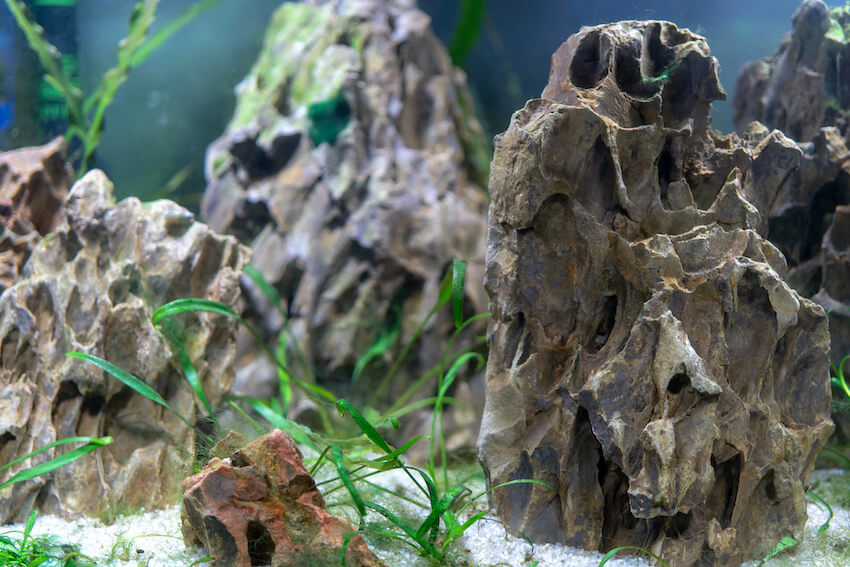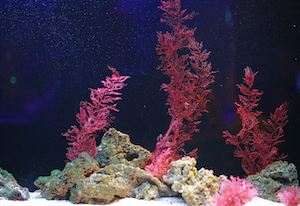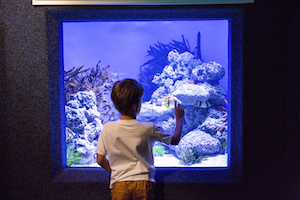
Our ideal aquarium layout is one that consists of stones and vegetation. We want our aquarium to have rocks, as we see in the bigger aquariums. These stones make it even more beautiful.
A random method is to purchase or pick any rock that catches our fancy and put it in the fish tank. This method’s danger is that every rock we put in the biosystem can affect its chemical balance.
Before dipping a rock into a freshwater aquarium, it is best to research the rock’s possible chemical effect.
Aquarium rocks along with sea plants help recreate the natural habitats of your fishes. The standard rock style used in aquariums is ‘Iwagumi,’ a Japanese term that refers to stones in the aqua-scaping world as the lone decorative material.
Beyond decorative purposes, rocks play other essential roles, such as a dwelling place for algae, beneficial bacteria, and fishes. It can serve as a shelter and a playground for aquatic organisms.
Aquasacaping, which is the art of arranging aquatic animals, plants, rocks, and other elements in an aesthetically pleasing form, is expanding. Today, there is a wide variety of forms in the market.
Aesthetics play a significant role in determining the type of rocks we use for our aquarium. This article will cover the different aquarium rocks, why you should bother adding rocks to your aquarium, and the best stones for freshwater aquariums.
Let’s get started.
Best Rocks for Freshwater Aquarium
Here are four of the best freshwater aquarium rocks.
1) Carib Sea ACS00370 South Sea Base Aquarium Rock
The Sea Base rock is famous for its aesthetic appeal but brings more benefits to the aquarium tank. It has a beautiful shape that provides enough room for your fish to play, conceal itself, and rest.
With a space porosity of 50%, it is a suitable rock that allows beneficial bacteria to grow and form colonies. Because water can easily pass through it, the stone can last for the long haul.
The rock is from the deep Carib Sea. It is an excellent fit for saltwater and freshwater tanks. Before using it for your freshwater aquarium, note that it has calcium carbonate and may require a higher pH level. However, it is a fantastic fit for some freshwater aquarium fishes, such as the African cichlids.
Pros:
- The company that makes it manufactures it in the US.
- Live rocks alternative.
- Available in multiple structures, sizes, and forms.
- It is a conducive environment for fishes and nitrifying bacteria.
- It has a void space of 50%.
Cons:
- The presence of calcium-carbonate substance requires a higher pH level.
2) Lifegard Aquatics Dragon Rock 10G Kit
The rock is a beautiful one that quickly catches the eye of the viewer. The company behind the creation is Lifeguard Aquatics, a renowned company that produces quality aquatic products.
When you purchase the aquatic rock kit, you get four small rock pieces and two larger pieces. You can arrange them in any style you want.
The natural freshwater rock kit comes with some special characters you can put in your aquarium to make it more lively and appealing for viewing.
The rock is porous and can host some contaminants that can affect the water or living organisms in your aquarium. Before dipping the stones into your tank, wash and let them boil in hot water.
This simple procedure will remove any contaminants hiding in the rock and stop them from raising the freshwater aquarium’s pH level.
Put the dragon rock in any freshwater tank, and it will blend naturally. The porous stones have lots of holes to provide shelter and a playground for the fishes and other beneficial bacteria.
Pros:
- It does not cause the pH to increase or hardens the water.
- Beautiful rocks.
- Available in several sizes.
- It can blend in any tank.
Cons:
- High price.
3) Natural Slate Stone
They are a perfect fit for any aquarium. It is also useful for decorating a garden. The company behind the slate stone is Small World, which has a reputation for producing top-notch slate pieces. All the rocks get created in the USA and meet up to industry-grade testing standards.
The natural slate stone is available in several sizes and shapes. The bigger sizes are perfect for building small caves, railways, plateaus, hills, and even dollhouses. In comparison, the smaller sizes can form beautiful parts.
This rock has smooth surfaces, which helps some aquatic animals lay, store and hatch their eggs. It is lightweight and will not add any significant weight to the tank.
The slate stone is perfect for freshwater aquariums. They do not tamper with the hardness of the water or its pH level. The rocks are capable of holding up the heat, which makes it an excellent habitat for reptiles.
The stones are not the strongest and can break if handled without caution. They come in a natural gray color.
Pros:
- Bargain price.
- Natural stones.
- It does not harden the water or changes its pH.
- It is excellent for building multiple creative structures.
- It comes in numerous shapes and sizes.
- It can harbor plant vegetation.
- It stores up the needed heat that reptiles need to thrive.
- An ideal fit for vivariums and terrariums.
Cons:
- The stones are fragile and can easily break if handled roughly.
- They are not the best rocks for large tanks.
4) Pisces 17lb Seiryu Rock
This rock is one of the best aquascaping stones available in the market. The unique Japanese name ‘Seriyu,’ which in English translates to “azure dragon,” reflects the rocks’ quality. Seriyu is a Japanese guardian spirit charged with taking care of ocean cities.
The Seriyu Rock has a bluish-grey color that blends in just about any aquarium’s decoration scheme. From any viewpoint, the rock complements the exact green color of the plants, colorful flowers, and the fish’s moving colors. Connect lights to the aquarium and watch the stones glow in the setting.
Seriyu Rock is available in different shapes and sizes. Experts are familiar with the concept of ‘Iwagumi Aquascaping’ and use these rocks to build small river beds, mountains, and valleys.
Issues surrounding the safety of the rock for plants, fish, and other beneficial microorganisms are non-existent. The rock is gotten from natural stones, healthy and free from harmful chemicals and toxins that can harm life in the aquarium.
However, the rock can cause a slight alteration to the aquarium water properties. The change is minute and does not pose any challenge.
When using the Seriyu Rocks, you want to moderate the quantity as more rocks can increase the aquarium’s pH and GH levels.
There is a solution if you prefer to use many of the elegant Seriyu Rocks. Add driftwood to the aquarium, and it will neutralize the water chemistry back to normal. The driftwood is a harmless neutralizer that does its job efficiently without causing any adverse effects on plants and life.
The rock has uneven edges and cuts that make it easy for fish to hide and play within it. You can stuff plants and moss into the stones for more beautiful scenery.
Pros:
- The rock is from concrete rock specimens, handpicked for the best quality.
- They are safe and not a health hazard.
- They come in various shapes.
- Good texture and cervices.
- Great value for money.
Cons:
- The rock is on the heavy side.
Buyer’s Guide: The Different Types of Aquarium Rock

A single rock can change the aquarium’s chemical balance, which can negatively harm plants and fishes in it. Before dumping any piece you feel is aesthetically pleasing into the aquarium, consider its possible ruinous effect.
Choosing the right aquarium rock is essential. You must consider the type of water (freshwater, marine, or brackish) before picking one. For instance, many freshwater fish can only thrive in low pH waters about 6.8 – 7.6.
Avoid putting calcareous (calcium-rich) rocks in a freshwater aquarium. It will increase the pH level and harden the water, causing harm to many tropical fishes that dominate aquariums.
Three main types of rocks are excellent freshwater aquariums: igneous rock, sedimentary rocks, and metamorphic rocks.
1) Igneous Rock
This common type of rock is a result of the cooling and solidification of magma or lava. Some examples include basalt, obsidian, gabbro, granite, rhyolite, scoria, lava rock, andesite, dacite, pumice, and tuff.
2) Sedimentary Rock
The gradual deposition of organic particles in lakes or rivers and its cementation creates this rock type. Sedimentation is the process by which these particles turn into a rock. Some examples include limestone, shale, sandstone, conglomerate, marl, breccia, chalk, iron ore, and rock salt.
3) Metamorphic Rocks
They are pre-existing rocks that alter that change their appearance due to exposure to high pressure, heat, and hot mineral-rich fluids, or the combination of all.
Rocks can change their physical or chemical form due to pressure and heat. Some examples of metamorphic rocks include dolomite, slate, marble, granite gneiss, and biotite schist.
The best aquarium rocks to use to soften the water and lower its pH are basalt and sandstone. If you want to harden the water and increase its pH, the best rocks are limestone and limestone.
Avoid heavy rocks in your aquarium, like granites; they add to the tank’s weight and can cause damage to your stand and aquarium.
Why Should You Use Rocks in Your Aquarium?

There are several reasons why adding rock to your aquarium is a good practice, apart from the apparent decorative reason.
- Rocks serve as a natural habitat on which beneficial bacteria can thrive. Every tank needs these bacteria to function as a biological filter and eradicate toxins like nitrites and ammonia. They help keep the tank water supply clean and healthy for pet fishes to thrive.
- They make the aquarium resemble the natural habitat of your pet fishes, keeping them happy.
- Rocks decorate the aquarium and the room at large.
- Rocks are suitable for growing plants such as algae that pet fishes can eat.
- They are a playground for pet fishes and a haven from predators.
Conclusion
Choosing a rock for your aquarium should not only cover its aesthetic value but its functionality. Before selecting a stone, check for its possible effect on fishes and plants in your aquarium. For freshwater aquariums, you want to avoid rocks that will increase their GH and pH levels.
Selecting the perfect non-toxic rock for your tank is one part of the job; the other part is its decoration. You do not need a manual to do this; check out for concepts online and let your imagination run wild.












